
It was time to board and see the plane where we would spend 13 hours to Singapore.

Flying over Iran


After several meals, a couple of halters, and a comfortable aircraft, with all sorts of technological gadgets and a crew, agile and friendly, we arrived at the airport of Changüi, Singapur. Looking from the aircraft, on early morning, with eyes glued after 13 hours of crossing, it is difficult to see and appreciate much less, the gigantic size of Singapur Airport. Only descending from the plane can one measure the enormity of the building. First an ultramodern design, where the only thing that clashes is the kilometres of carpet that are inexplicable in an atmosphere of such moisture as it is Indonesia. But well, asking the designer I am sure he would giveus an explanation.







The stores that make up the commercial offer are ultraluxury: jewelry, Swarovski Crystal, Pearl...Clothing stores range from international chains to the most exclusive, as Hermes.





So does the restoration, with the omnipresent Mac Donalds or Burger King and the Almighty Asian KFC. It's funny to find authentic gardens with waterfalls, appliances for massaging your legs and re-establish your circulation after a long trip... but I was much more surprised by two things.


First the powerful and free WIFI... unbeatable, and second the importance given to the condition in which are the top design toilets. A lush garden with scents that float in the air will accompany us if we want to pay a visit, and do not forget to leave without qualifying in the visor the condition in which we found the toilets, with a photo of the person responsible for that day.


A world to be discovered with the more modernized Oriental customs...
But dawn was approaching, and with it the flight that would take us to Bali. On this occasion we would fly with Garuda, belonging to Singapore Airlines. The flight lasted for 2,15 hours and I had breakfast with coffee, although there were who did it with delicious Bintang, the Indonesian beer.




We begin to see the Islands and islets that make up the Sunda Islands

An we arrived to Bali



After crossing the security controls, pay rates of immigration (about € 8, $10) and pick up the lugagge, we walked to the entrance of the airport, where the rental car is waiting for us. Once accommodated in it, we headed to our rented house in Seminyak. By the way we wonder of things like this, which one gets used to about the second day.

After a long searching in my internet pages of reference to the rental a home such Homeaway and Interhome, love emerged at first sight. The villa was among the first to appear, and as we went by selecting, was the one which we liked more, until we decided not to go on looking for, because we always returned to her. So, after the first contacts with Menur and Florent, the friendly owners of the house, the adventure started. We reserved and waited. Finally we come to Bali, and after picking up a car that also the owners of Azurvilla managed, we headed to the nearby Seminyak. After a couple of laps motivated by our disorientation, but with the kind help of the Balinese, very soon we arrived at the Villa.

The photos, as usual, were short with what reflected.The color of each corner was most striking, photos not conveyed the feeling of peace and tranquility breathed in the house, the amplitude and luminosity of rooms...It was awaiting us Menur, a very beautiful and friendly woman who put us abreast of all matters relating to the house and Bali. She advised us to the best places, offered us an ice cold Bintang Beer (which make us addicts), and she put at our disposal for everything we were willing. Thank you Menur, was a pleasure to meet you!!.Once the owner retired, we explored the house.The entry being at the same time garage, then the wonderful garden where the house opens with a fantastic pool and cared for by an expert gardener. The truth is that the fountain of Buddha and the sound of the water, were like music in silence.





Orchids, a precious frangipan of fragrant flowers and dozens of plants and trees adorn the space that becomes the center of the village. I had even a nest with two sparrows on the door of my room!



A large living room- kitchen with bar was our place for breakfast, dinner and gathering (with many moments of connection with our family and friends thanks to the WIFI) also it was the scene of the wonderful Indonesian dinner prepared by our private chef. Delicious!!.

The villa has three beautiful and spacious rooms decorated in a simple but very elegant style, wide and comfortable beds, gigantic and well distributed wardrobes.... But most important, every room has its own bathroom with a great shower open to the sky, which makes that freshen up before we go to bed quite an experience with the view of the stars.











The house stays perfectly clean thanks to the care of a great assistant that makes their task 6 times a week. Less than 100 metres there is a shopping centre with supermarket, Pizza Hut, Burger King and the start of several trade routes and streets, locating the villa in the Centre but away from the noise and bustle.The truth is that it was a delight to arrive after a hard day of sightseeing, having a beer with peanuts from Bali and taking a swim in the pool.




I am sure that if I go back to Bali, I will return to the same place and the same house. Without any doubt.
That day, or what was left of it, was asigned to rest, buy food and adapt us to the new timetables. But the following day we started the first of our planned routes, that would take us to the center of the island.With the car, we quickly got in the first of the destinations, Batubulan, where there is a unique, represented at 9.30 in the morning, everyday function of dance and theatre Barong, by one of the most famous companies of Bali. We parked the car and after passing ahead of the Pavillion of the community and pay the entrance fee we sat down to watch the show.

This is one of the most famous folk dances of Bali. The Barong is a mythological animal that represents the spirit of the Good and the Rangda represents its opposite, Evil. The story that dancers represent talks about Dewi Kunti, mother of the five Pandawa, that promised to sacrifice one of his sons, Sadewa, to Rangda.At the beginning the Barong appears with his monkey friend and three masked men which are farmers and they are angry with the Barong for killing the son of one of them. They attack the Barong, which monkey defends.


There is now a small interlude where two girls dressed elegantly danced the Legong dance.


Two servants of Dewi Kunti appear on stage talking about the sacrifice that will kill Sadewa. At the moment appears the Minister Pathi.



Kunti appears onstage with a servant and then appears Sadewi. Dewi regrets having to sacrifice him, but then appears a witch and bewitches her, that goes crazy and orders the Minister to take Sadewa to the grave where Rangda lives.


The witch also bewitches the Minister who leads Sadewa to the abode of the Rangda and binds it to a tree.While they await the arrival of the Rangda, Good Lord Shiva appears and grants him immortality.

The Rangda is transported on the shoulders of his followers, and he is ready to kill Sadewa, but because of his inmortality he cannot do it. So he decides to redeem himself and asks Sadewa to kill him and send him to Heaven. The wish is granted.





Rangda had a disciple, Kalika, who wants to be also redeemed but Sadewa rejects her and starts a fight. Kalika becomes a wild boar but she is defeated.

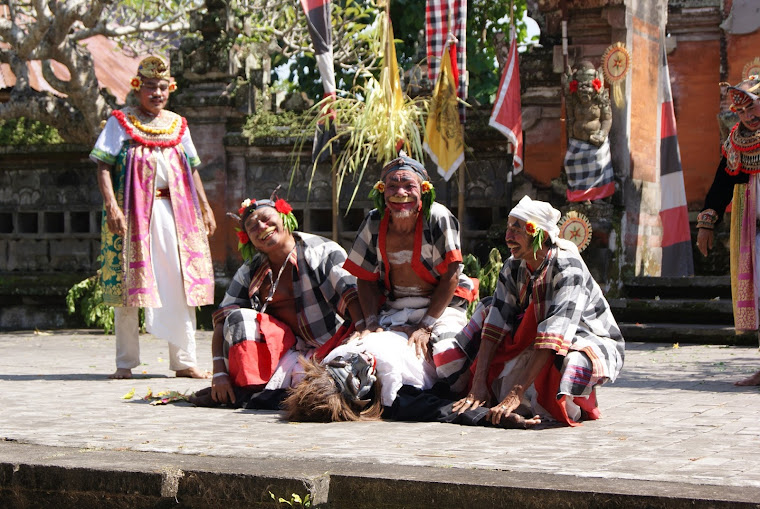
She comes again in the shape of a bird but she is defeated again.

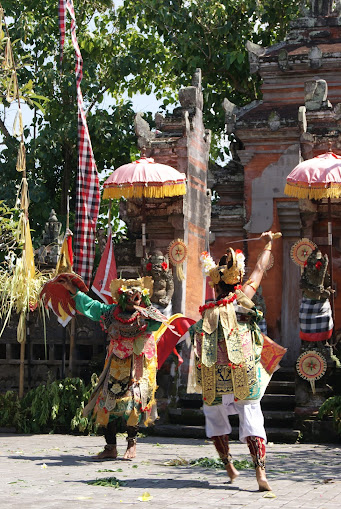
Kalika finally becomes Rangda and Sadewa, to confront such power is transformed in Barong.

But the powers are very similar, so Sadewa called his followers.

Followers arrive and attack the Rangda but they cannot destroy him, because he embodies Evil, and without him there would not be Goodness . To express their fury they wound themselves.

The priestess of the temple makes offerings and pours water to the dancers.

It becomes a sacrifice that stabilizes the fight of powers and makes the harmony rule again over the Earth.With this the play ends.



As we looked really interested in the dance, we were invited to visit the actors and have a closer wiew of the masks. It was a unique moment.


Then we visited the temple which was just side by side. Pura Puseh is the central Temple of the village of Batubulan, belonging to Gianyar and that is slowly being absorbed by the growing Denpasar.


Famous for its handmade masons, anything that comes out of his hands, has the quality guarantee over all Bali. And that is because tradition has not been lost, especially if we take into account the work highlighted in this temple, one of the most beautiful of Bali, but where we can only see the very ornated door, since like most of the temples of Bali entry is not permitted to non-Hindus.





Anyway, we got a slow glance to every detail, every sculpture, and a glimpse of the interior of the Temple from the door (that it is allowed).









Around him, a beautiful moat filled with lotuses and water lilies in a competence for giving color to the water. A delightful view. We left the venue and on the way to the center of the island made a stop to see the sculpture of a giant baby which people worship as a God. And that is relatively new, well, the sculpture, because the myth does not. Blahbatuh, would pass unnoticed as one village more in the road for visitors (except for the Chinese Buddhist, because there is a huge Temple which brings together all the practitioners of this religion of South Bali), if it wasn't because in the center, in a space where three highways converge rises, since 1990, a huge statue in stone of a baby.


For some people he is the giant of the village Kebo Iwo as a child, for others, is part of a legend that tells that the women from a nearby village urged their husbands to build a figure to appease a demon who claimed the lives of children.


Whatever the origin of the place, what cannot be denied is its religious content, since you can watch daily the locals that cross the roads to make offerings to the giant child. Perhaps in this way he does not claim the newborn...The truth is that the first time (say first because the town is at the confluence of several highway routes and almost every day we passed by it) impresses and shocks, but then it becomes familiar, a sign of its proximity and it was very close to our accommodation.The funny thing is that it seems older than it is... is the stone?
Following the road, because a little away from the main road there is one of the strongest points of the journey, we find the Cave of the Elephant, without any doubt, one of the most spectacular and smaller temples that I have seen in all my travels.
Spectacular, because it is carved into the rock of the mountain, with a beautiful and intricate design, and small because it is a tiny space.The strangest thing of all is that this cave-temple was not known by the Europeans, who walked half Asia, until 1923, although it was built approximately on the XI century. It is not surprising, because it is not very visible from the road. You must leave your car in a parking surrounded by lots of sarong shops and get to the set of temples and ponds that are 100 metres down the way. We religiously payed the entrance, took the waist sarongs and enter. After another set of shops, the first thing we see is a few ponds where water flows constantly and swim some fish that look like tents.





The large springs excavated in 1954 were probably used for sacred baths.After these, we see the Elephant Cave, with a huge face carved on the outside and after entering it seemed small and stifling with its T shape, their niches with Shivit and Buddhists statues and incredible humidity.




So the visit can not end here, we have to walk a little more and visit the shrine of the goddess Hariti, protective of children, where a monk, for a "donation", blesses you with water from the nearby sacred springs.
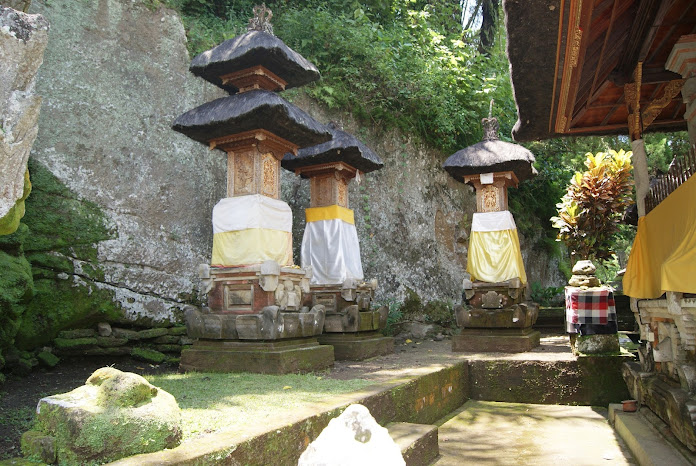











A little further down, there is a delicious corner with a beautiful pond of lotusses and another sacred niche.

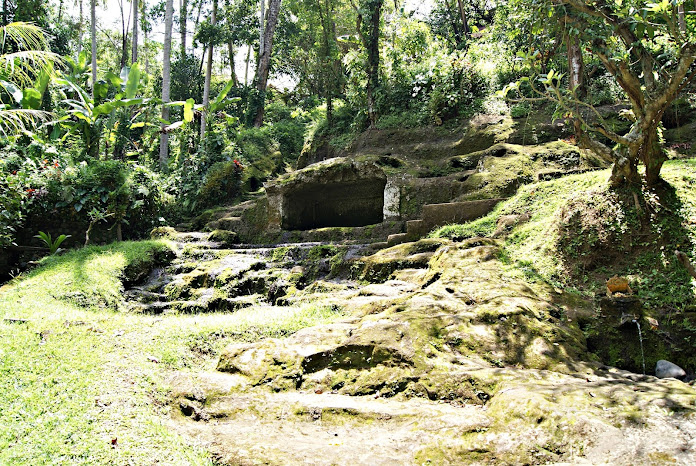
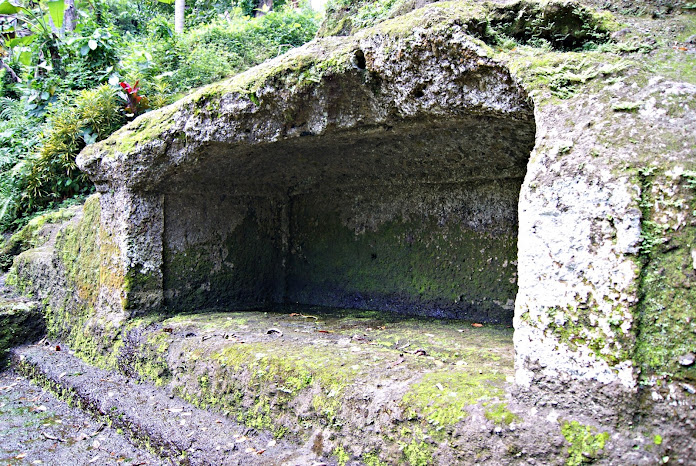

And from there we went to Ubud. Although it is not a big city, Ubud has become one of the places that you must visit in Bali, even when it does not have too many tourist attractions, just five. The funny thing is that best dances and purest artistic representations can only be enjoyed here. Wonders of tourism.
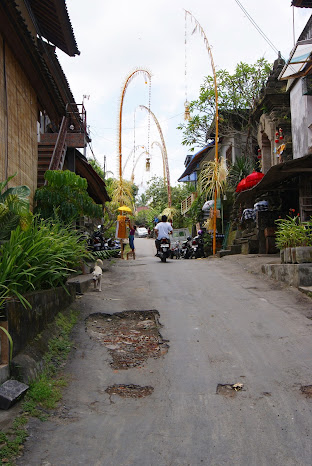
Although it is barely more than a great street that crosses from one side to another, it is full of shops, restaurants and the most varied services that make it focus of attraction for any visitor of Bali.

There are moments of the day that becomes a really busy place and therefore is the best time to make the visit to the Temple of Pura Desa, on the same main avenue.






It is always appreciated that people allow visitors to get to a temple of any religion in the moments of prayer, but if you are welcomed with a smile and invited to come and shoot, you cannot ask for more. So taking advantage of the innate kindness of the Balinese, and always with respect, we get closer and enjoy their most intimate moments of faith.The second courtyard of the temple is normally used for ordinary ceremonies, while the first, larger, is used only in the important celebrations.








We were hungry, so we granted ourselves a luxury moment and we ate in the Lotus Cafe. A marvellous place!.
Although it appears in several guidebooks on Bali, and in the mouth to ear it has always a place, it does not highlight as the best food on the island, although it seemed to us more than acceptable.

It is fully integrated into the set of buildings that conform the entrance to the Temple of Pura Saman Saraswati, and there is no better place to enjoy the food and the views of the Lotus pond and the temple that the table that we were offered to seat at.

The service, as in all Bali, was very fast and efficient and portions to share are more than sufficient.We have to bear in mind, that as almost all oriental food is quick to digest, so in a couple of hours we will be hungry again.

A few ice cold Bintangs accompany a series of dishes that we ask to share and have a general idea of the cuisine of the place.One of the dishes would be like our tapas, a selection of goodies to chop, which is called Makanan Ringan, which consisted of Lemper (rice and chicken), Sambal Udang (spicy prawns), Pepes Ikan (fish cooked in banana leaf), Tumis Terung (sauteed Eggplant), Tahu Bergedel (fried tofu cakes) and Rujak (fruit pickled in the style of Bali)

Then we continue with Ayam Sisit, chicken breast marinated with sayur lodeh (vegetables cooked with coconut milk) and lightly spicy cooked rice.

We finished with Sate Lilit Kambing, brochettes of lamb seasoned with balinese spices. grilled, with chips of coconut, lawar of balinese vegetables, rice and sambal, which is the hot sauce.

The price is not high nor low. It is not like eating in the street that can cost about 2 euros per person. Here, tourism makes prices increase about 16 euros per person.Anyway, the environment, well worth it.We visited, before leaving, the Temple which we had been enjoying


Ubud is known throughout the island as the village of painters. In the 1930's the Royal family promoted the love for the arts, in such a way that intellectuals, artists and foreigners who wanted to meet the real Bali found their place in the Village. Here was born the desire to preserve traditions and the cultural balinese heritage.One of the artists who came there was I Gusti Nyoman Lempad and he built this temple, who seems older than it is, commissioned by the Prince of Ubud in honor to the goddess of wisdom, education and arts, Saraswati.


The scenery is wonderful, since the Lotus pond that precedes it is an authentic work of art, with jets of water in the form of gnagas which reflects the set in a magical way.



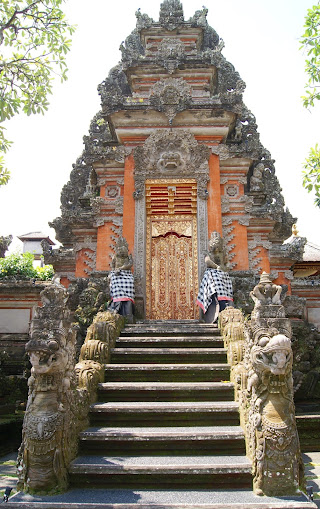

Once inside, several altars called my attention, like the three meter statue of the demon Jero Gede Mecaling and the shrine dedicated to the Supreme God, with a stone seat which houses Him in religious ceremonies, as He descends from heaven, since the gods are periodically invited to embody in the pratima or effigies which are kept in the sanctuaries.




We can also see the dresses of Rangda and Barong used in representations of the theatre taking place every night in the lobby of the temple.






It is not a large venue, but it is full of details that catch our attention, like the mountain of offerings to a hungry cat (or a mischievous God incarnate in it) who finally throws it down the stairs, or the beautiful figures that embody the thousand gods of Hindu religion in his particular balinese version.





The temple is normally not open, except on certain hours. You must come by the right side and keep strictly the rules of respect, wearing sarong and sash.






Although it seems that no one is there, we must observe the rules since respect is due to the established customs, and that applies to all the temples of Bali. I can guarantee, that respect and imitating their customs is something that the Balinese are deeply grateful to and it is not strange that we observe their smile when they see that we do it.

After here, and to finish the day we went to Pura Tirta Empul, the sacred springs.
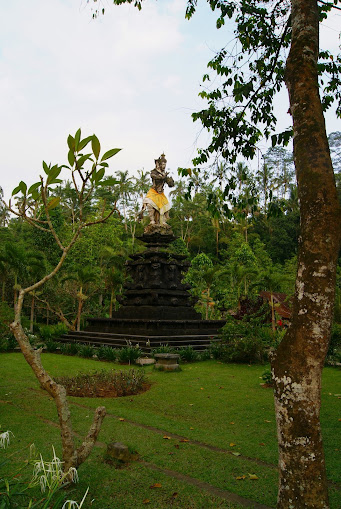
It seems that late in the afternoon is the best time to visit some sacred places in Bali, mostly the more intimate and less crowded. So we take what was left of sunlight to get closer to Pura Tirta Empul, close to Ubud, where the Pakrisan River is born.

The entrance, is very cheap, just 1 euro and walking by a delightful garden, full of beautiful trees and plants we entered in this really spectacular place.



We arrived to a few courtyards with rectangular pools whose pipe sprout specific kinds of sacred water that devotees are grateful to with abundant and elaborate ritual offerings.




Where is the origin of that water? There is the curiosity of the site, since other top pond holds the secret.The water that comes from the nearby river passes first by a pond where there is a volcanic heat output, which is perfectly visible thanks to mud that swishes constantly close to the surface and the movement of the algae and aquatic plants that live in the crystal clear water.



Next to this pond stands the temple itself that dates back to the X century, although the walls enclosing the grounds, where it is not allowed to enter, are more recent.


There is always a faithful praying, although the best time is the full moon period.
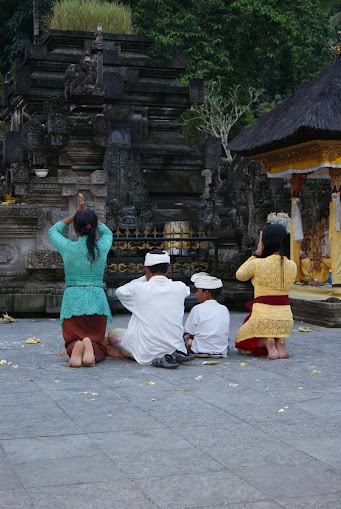
When we are at this point, let's look toward the hill.There are strikingly modern buildings overlooking the temple: the Government Palace, built in 1954. It was originally a residence for Dutch officials, to be used later by the former President Soekarno during his frequent trips to Bali.

The light does not leave us to enjoy this peaceful enclave, so we return home...

No hay comentarios:
Publicar un comentario